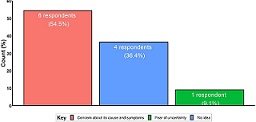Perception and Knowledge of Cancer and Cancer Screening among Staff of Military Hospital Lagos

Abstract:
Perception and knowledge of cancer remain poor in developing countries. Problems associated with cancer incidence include late reporting due to fear,
ignorance and financial constrains relating to cancer screening. This study sought
to determine the perception and knowledge of cancer among health workers in Lagos.
Method: A mixed-method study design comprising a qualitative study (Focus Group
Discussions and In-depth Interview) and a quantitative study was employed to collect
information from the staff of Military Hospital Lagos, southwest Nigeria. 30 Participants
for the qualitative study were purposely recruited, while 200 participants for the
quantitative study were selected using the proportional probability sampling technique
after approval was received from the management of the hospital. Qualitative data
was recorded using a recorder, transcribed verbatim, and analyzed thematically.
Quantitative data was analyzed using SPSS 25.0 software at 95% CI, alpha set at
5%. Findings: The majority were women, 16(64.0%), with only 8(27%) of them under
health insurance, with a minimum qualification of secondary school certificate,
and mostly health attendants in the group discussion, while those in the interview
group were all health professionals. The quantitative study revealed more males
106(53.0%), 73(36.5%) between 20-30 years, with 114(57.0%) married, over half, 122(61.0%)
possessed a college degree, average income being >50-100 thousand naira monthly,
132(66.0%) respondents had health insurance. All cited fear and death sentence on
hearing “cancer”, most had limited knowledge about cancer screening, only 5(2.5%)
had any screening in the last 6 months.
References:
[1] Globocan 2012:
Estimated Cancer Incidence, Mortality and Prevalence Worldwide in 2012 v1.0. IARC CancerBase No. 11. ISBN-13, 978-92-832-2447-1.
[2] Harcourt N, Ghebre RG, Whembolua GL,
Zhang Y, Osman SW, & Okuyemi KS. (2014). Factors associated with breast and
cervical cancer screening behavior among African immigrant women in Minnesota. Journal
of immigrant and minority health, 16(3), 450-456.
[3] Tapera O,
Nyakabau A, Simango N, Guzha B, Jombo-Nyakuwa S, Takawira E, Mapanga A, Makosa D,
& Madzima B. (2021). Gaps and opportunities for cervical cancer prevention,
diagnosis, treatment, and care: evidence from midterm review of the Zimbabwe cervical
Cancer prevention and control strategy (2016–2020). BMC Public Health. 21. 10.1186/s12889-021-11532-y.
[4] Silvera,
S. A. N., Bandera, E. V., Jones, B. A., Kaplan, A. M., & Demisse, K. (2020).
Knowledge of, and beliefs about, access to screening facilities and cervical cancer
screening behaviors among low-income women in New Jersey. Cancer Causes &
Control, 31(1), 43-49.
[5] Logan L. & Mcilfatrick S. (2011).
Exploring women's knowledge, experiences, and perceptions of cervical cancer screening
in an area of social deprivation. European Journal of Cancer Care20, 720–727. doi.org/10.1111/j.1365-2354.2011.01254.
x.
[6] Sheeran
P, Harris PR, Epton T. (2014). Does a heightening risk appraisal change people’s
intentions and behavior? A meta-analysis of experimental studies. Psychological bulletin, 140(2), 511–543. https://doi.org/10.1037/a0033065.
[7] Adetona AE, Osungbade KO, Akinyemi OO,
Obembe TA (2021). Uptake of Breast Screening Among Female Staff at A Tertiary Health
Institution in South-West Nigeria. Journal of Preventive Medicine and Care
- 3(2):17-30. Doi 10.14302/issn.2474-3585.jpmc-20-3557.
[8] Keah MM, Kombe Y, & Ngure K. (2020).
Factors Influencing the Uptake of Cervical Cancer Screening among Female Doctors
and Nurses in Kenyatta National Hospital. Journal of Cancer and Tumor International,
10(3), 31-38. https://doi.org/10.9734/jcti/2020/v10i330131.
[9] Odenusi AO, Oladoyin VO, Asuzu MC (2020).
Uptake of cervical cancer screening services and its determinants between health
and non-health workers in Ibadan, south-Western Nigeria. Afr. J. Med. Med. Sci.
(4) 49, 573-5.
[10] Bukowska-Durawa
A, & Luszczynska A. (2014). Cervical cancer screening and psychosocial barriers
perceived by patients. A systematic review. Contemporary oncology (Poznan, Poland),
18(3), 153–159. https://doi.org/10.5114/wo.2014.43158.
[11] Bradley
DT, Treanor C, McMullan C, et al. Reasons for non-participation in the Northern
Ireland Bowel Cancer Screening Programme: a qualitative study. BMJ Open 2015;5:
e008266. doi:10.1136/ bmjopen-2015-008266.
[12] Marlow LAV,
Waller J, & Wardle J. (2015). Barriers to cervical cancer screening among ethnic
minority women: a qualitative study. The journal of family planning and reproductive
health care, 41(4), 248–254. https://doi.org/10.1136/jfprhc-2014-101082.
[13] Marlow LAV,
Wardle J & Waller J. (2015). Understanding cervical screening non-attendance
among ethnic minority women in England. Br J Cancer 2015;113(5):833–839. Doi:10.1038/bjc.2015.248.
[14] Chorley
AJ, Marlow LAV, Forster AS, Haddrell JB & Waller J. (2016). Experiences of cervical
screening and barriers to participation in the context of an organized program:
a systematic review and thematic synthesis. Psycho-Oncology 26: 161–172. Doi: 10.1002/pon.4126.
[15] Wright KO, Faseru B, Kuyinu YA, Faduyile
FA. (2011). Awareness and uptake of the Pap smear among market women in Lagos, Nigeria.
J Public Health Afr; 2(e14): 58-62. https://doi.org/10.4081/jphia.2011.e14.
[16] Vrinten
C, McGregor LM, Heinrich M, von Wagner C, Waller J, Wardle J, Black GB. (2017).
What do people fear about cancer? A systematic review and meta-synthesis of cancer
fears in the general population. Psycho-oncology 26(8):1070-1079. doi: 10.1002/pon.4287.
[17] Vrinten
C, Waller J, von Wagner C, Wardle J. (2015). Cancer fear: facilitator and deterrent
to participation in colorectal cancer screening. Cancer Epidemiol Biomarkers Prev;
24(2):400-5. doi: 10.1158/1055-9965.EPI-14-0967.
[18] Licqurish
S, Phillipson L, Chiang P, Walker J, Walter F & Emery J. (2017). Cancer beliefs
in ethnic minority populations: a review and meta-synthesis of qualitative studies.
European journal of cancer care, 26(1), 10.1111/ecc.12556. https://doi.org/10.1111/ecc.12556.
[19] Dim CC, Ekwe E, Madubuko T, Dim NR, Ezegwui
HU. (2009). Improved awareness of Pap smear may not affect its use in Nigeria: a
case study of female medical practitioners in Enugu, southeastern Nigeria. Trans
R Soc Trop Med Hyg. 103(8): 852-854.
[20] Dim C C.
(2012). Towards improving cervical cancer screening in Nigeria: A review of the
basics of cervical neoplasm and cytology. Niger J Clin Pract 15:247-52.
https://www.njcponline.com/text.asp?2012/15/3/247/100615.
[21] Dim CC,
Nwagha UI, Ezegwui HU & Dim NR. (2009). The need to incorporate routine cervical
cancer counseling and screening in the management of women at the outpatient clinics
in Nigeria, Journal of Obstetrics and Gynaecology; 29:8, 754-756, Doi: 10.3109/01443610903225323.
[22] Jensen LA, Allen MN. (1996). Meta-synthesis
of qualitative findings. Qual Health Res;6 (4):553–560. Doi:10.1177/10497323960060
040.
[23] Dharni N,
Armstrong D, Chung-Faye G, & Wright AJ (2017). Factors influencing participation
in colorectal cancer screening - a qualitative study in an ethnic and socio-economically
diverse inner-city population. Health expectations: an international journal
of public participation in health care and health policy, 20(4), 608–617.
https://doi.org/10.1111/hex.12489.
[24] Hewitson
P, Ward AM, Heneghan C, Halloran SP & Mant D. (2011). Primary care endorsement
letter and a patient leaflet to improve participation in colorectal cancer screening:
results of a factorial randomized trial. British journal of cancer, 105(4),
475–480. https://doi.org/10.1038/bjc.2011.255.

